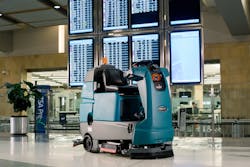How to Implement Autonomous Floor Cleaners in Airport Terminals

Airports across North America are exploring automation inside their terminal operations to ensure safe, secure and enjoyable environments for travelers.
Autonomous floor cleaners have been one of the leading technologies for airports looking to gain operational efficiencies inside the terminal especially since the start of the COVID-19 Pandemic.
Dennis Collins, Senior Global Category Product Line Manager for Tennant Co. shares some of the following tips for airports looking at autonomous floor cleaners and what they should consider when implementing the units inside their terminal.
Prepare for Your Machine
Autonomous floor cleaners come with a variety of options from different manufacturers. Collins said you should know what the user interface looks like before purchasing an autonomous machine. Some are touch screen while others use button interfaces, which Collins says may require a manual for operators to understand.
You also need to know when and how people move in your terminal. Autonomous machines will work slower or stop when large amounts of people are inside the terminal. Preparing autonomous scrubber deployment for slower traffic times inside the terminal reduces the delays in operation.
“Airports in general are a great environment for robotic scrubbers common areas,” Collins says. “It’s great for those long terminals.
Collins said it can work as a “co-bot” for maintenance staff for better operational efficiencies. Someone cleaning a bathroom can run an autonomous floor cleaner at the same time and increase cleaning.
Maintenance Remains the Same
Collins said regular maintenance issues for autonomous sweepers aren’t drastically different from traditional units. LIDAR, sensors and a control module are added to the units, but they’re warranty-covered aspects of the machines and not a focus of ongoing maintenance for airport crews.
Brush use is the same as a traditional unit, however, operators are prone to use autonomous units more often when they require just a push of a button to deploy them. More usage will mean more frequent replacement of brushes.
Basic maintenance like watering a battery still must be followed, but other steps such as cleaning sensors with a microfiber cloth needs to be addressed.
Maintenance Becomes More Visible
Collins said the new technology makes ongoing maintenance needs more visible to staff. The user interface of a Tennant machine contains videos for daily and weekly maintenance routines so staff can watch and refer to them when addressing maintenance needs. Providing these best practices on demand ensures the machines will run optimally by sharing best practices with crewmembers.
Tennant also offers maintenance plans and proactive monitoring of equipment so facility maintenance crews are alerted when a part may be about to fail.
Use Them How You Need
Autonomous floor cleaners are not much different than traditional units. You can even run them manually if you so choose.
Collins says this means there doesn’t have to be a radical shift in machine maintenance or how its used in the terminal. Tennant identified KPIs to determine if the unit is being used as effectively as possible, such as square feet cleaned, and time used. The data can be examined on a weekly basis to optimize operations.
“We have a baseline of what we think good looks like and work with them to define good,” Collins said. “We’re very vested in seeing robotics used we don’t want to drop off a robot and say good luck. We want them to see a ROI when buying one. We want them to be successful.”
About the Author
Joe Petrie
Editor & Chief
Joe Petrie is the Editorial Director for the Endeavor Aviation Group.
Joe has spent the past 20 years writing about the most cutting-edge topics related to transportation and policy in a variety of sectors with an emphasis on transportation issues for the past 15 years.
Contact: Joe Petrie
Editor & Chief | Airport Business
+1-920-568-8399
>> To download the AviationPros media kits, visit: Marketing Resource Center
>>Check out our aviation magazines: Ground Support Worldwide | Airport Business | Aircraft Maintenance Technology
